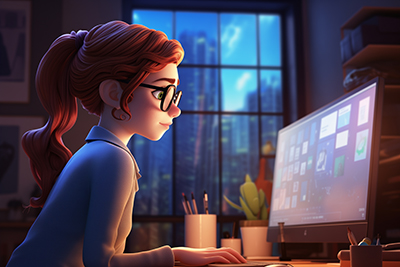How to Start Graphic Design at Home
How to Start Graphic Design at Home
Welcome to the world of graphic design! Whether you’re an aspiring artist, a seasoned professional, or just someone with a passion for creativity, starting your journey in graphic design from the comfort of your own home is an exciting and achievable goal. In this comprehensive guide, we’ll explore the steps you need to take to kickstart your graphic design career right from your home base. Let’s dive into your journey of graphic design at home.

1. Define Your Goals
Before diving headfirst into the world of graphic design, take some time to define your goals. Ask yourself what you hope to achieve through graphic design. Are you looking to build a freelance career, create stunning visuals for your own projects, or perhaps start your own design business? Clarifying your objectives will help guide your learning and career path.
2. Invest in the Right Tools
One of the great things about starting graphic design at home is the minimal startup costs compared to traditional brick-and-mortar setups. Yet, it’s pivotal to invest in the appropriate tools. Ensure you have a reliable computer or laptop with graphic design software installed. Popular choices include Adobe Photoshop, Illustrator, and InDesign, though there are many affordable or even free alternatives available.
3. Learn the Fundamentals
Graphic design is more than just pushing pixels around. It’s about understanding design principles, color theory, typography, and composition. Fortunately, there are countless online resources, tutorials, and courses available to help you learn the fundamentals of graphic design at your own pace. Dedicate time each day to study and practice these essential concepts.
4. Practice, Practice, Practice
As the saying goes, practice makes perfect. The more you practice your design skills, the better you’ll become. Experiment with different styles, techniques, and projects to broaden your skill set and find your unique voice as a designer. Embrace the journey and don’t shy away from mistakes – they’re stepping stones on the path to mastering your craft.
5. Build Your Portfolio
As you gain confidence in your skills, start building a portfolio of your work. Your portfolio is your visual resume and showcases your abilities to potential clients or employers. Include a variety of projects that highlight your versatility and expertise in different areas of graphic design. Keep your portfolio fresh by consistently adding new projects and honing your skills along the way.
6. Network and Collaborate
Networking is paramount in the realm of graphic design. Join online communities, forums, and social media groups to connect with other designers, share knowledge, and stay updated on industry trends. Collaborating with fellow designers on projects can also provide valuable learning experiences and exposure to different approaches and perspectives.
7. Market Yourself
Once you feel confident in your skills and have a solid portfolio to showcase, it’s time to start marketing yourself. Create a polished website or online portfolio to showcase your creations and captivate prospective clients on social media platforms to showcase your projects, engage with your audience, and establish yourself as an authority in your niche.
8. Seek Feedback and Continuous Improvement
Feedback is essential for growth as a designer. Don’t hesitate to seek constructive criticism from peers, mentors, or clients on your work. Use feedback as an opportunity to identify areas for improvement and refine your skills further. Remember, learning and growth are ongoing processes in the ever-evolving field of graphic design.
9. Stay Inspired
Graphic design is a dynamic and creative field, but it can also be challenging at times. To stay inspired and motivated, expose yourself to a wide range of design work from different artists and industries. Draw inspiration from art, nature, architecture, and everyday life. Keep pushing yourself out of your comfort zone to explore new techniques and ideas.
10. Stay Updated on Trends and Technology
Finally, stay updated on the latest trends, techniques, and technologies shaping the graphic design industry. Follow design blogs, attend workshops and conferences, and participate in online courses to stay ahead of the curve. Embrace lifelong learning and adaptability as you navigate your journey in graphic design.
Conclusion
Starting graphic design at home is an exciting and rewarding endeavor that offers endless opportunities for creativity and growth. By defining your goals, investing in the right tools, learning the fundamentals, and continuously practicing and improving your skills, you can pave the way for a successful career in graphic design from your own home. Keep in mind, success thrives on your fervor, unwavering resolve, and an unwavering dedication to perpetual growth. Ready to dive in? Let’s kickstart your graphic design adventure today!
Frequently asked questions
Q1: What should I do before starting my graphic design journey at home? A1: Before diving into graphic design, define your goals to guide your learning and career path effectively.
Q2: What are the essential tools I need to start graphic design at home? A2: Invest in a reliable computer or laptop with graphic design software like Adobe Photoshop, Illustrator, or InDesign.
Q3: How can I learn the fundamentals of graphic design from home? A3: Utilize online resources, tutorials, and courses to learn design principles, color theory, typography, and composition at your own pace.
Q4: How important is practice in becoming a proficient graphic designer? A4: Practice regularly to improve your design skills, experiment with different styles, and embrace mistakes as learning opportunities.
Q5: Why is building a portfolio crucial for graphic designers? A5: A portfolio showcases your skills and expertise to potential clients or employers, demonstrating your versatility and proficiency in graphic design.

